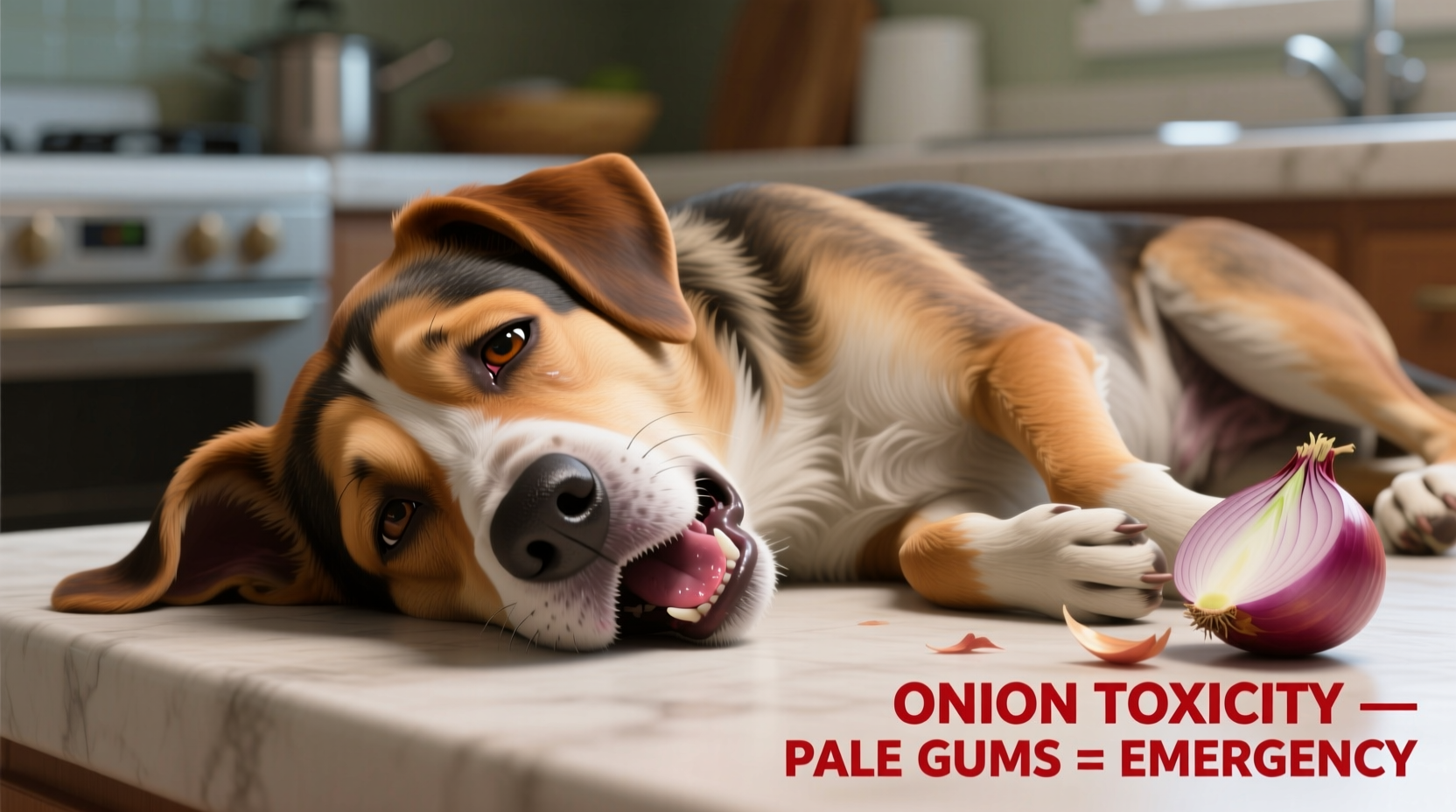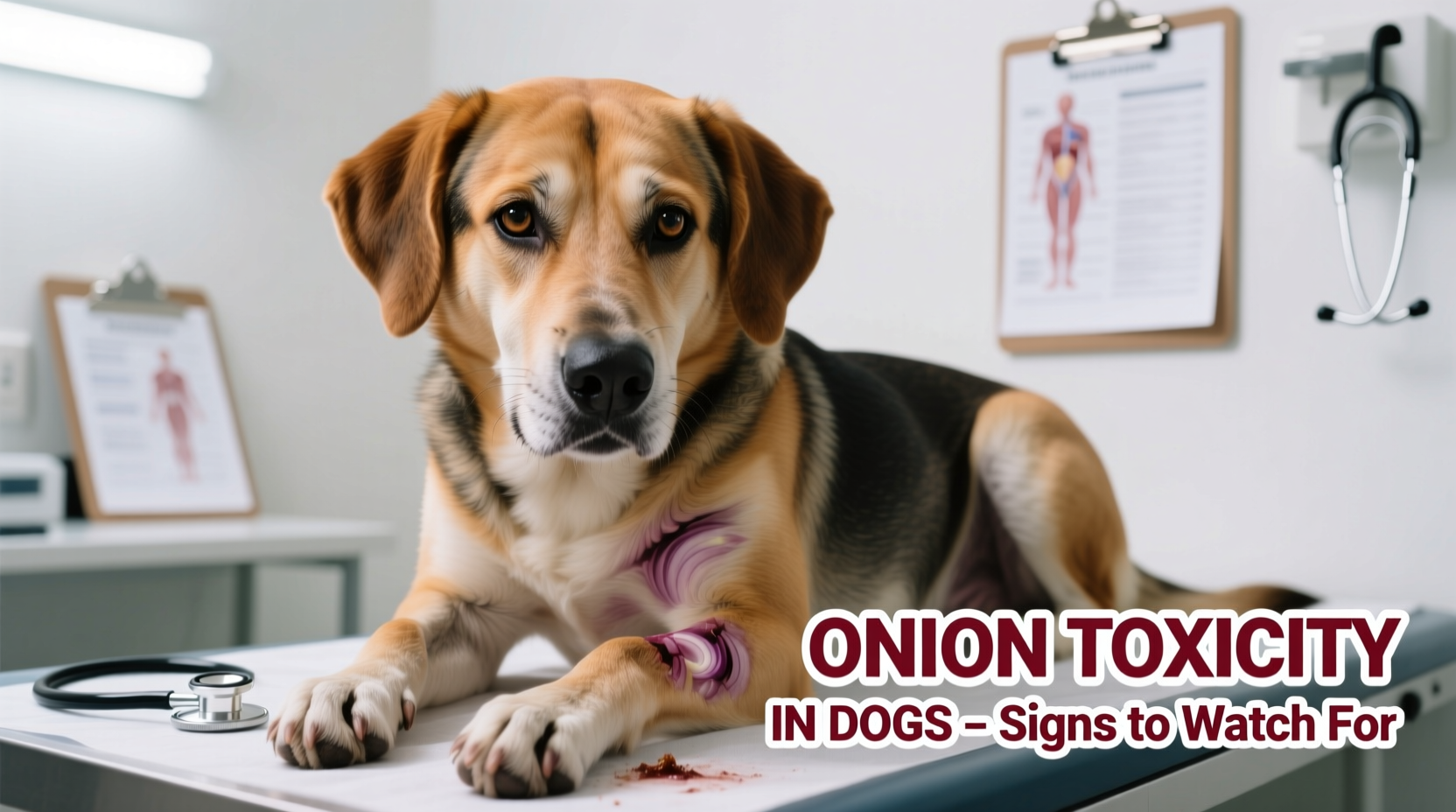Onion toxicity in dogs causes weakness, vomiting, diarrhea, pale gums, rapid breathing, and collapse. Immediate veterinary care is essential as symptoms can progress rapidly and become life-threatening within hours of ingestion.
If your dog has eaten onions, garlic, or related plants, recognizing the early signs of toxicity could save their life. This guide provides vet-verified information about onion toxicity symptoms in dogs, including what to watch for, when to seek emergency care, and how to prevent this dangerous condition.
Understanding Onion Toxicity in Dogs
Onions, garlic, leeks, and chives contain compounds called N-propyl disulfide that damage red blood cells in dogs, leading to hemolytic anemia. Unlike humans, dogs lack the enzyme needed to process these compounds safely. Even small amounts can be toxic—just 15-30 grams of onion per kilogram of body weight can cause poisoning.
According to the ASPCA Animal Poison Control Center, onion toxicity accounts for approximately 12% of all plant-related pet poisonings reported annually in the United States.
Timeline of Onion Toxicity Symptoms in Dogs
Symptoms don't appear immediately after ingestion. Understanding the progression timeline helps pet owners recognize when to seek urgent care:
| Time After Ingestion | Early Warning Signs | Advanced Symptoms |
|---|---|---|
| 0-24 hours | Mild lethargy, decreased appetite, occasional drooling | Rarely seen at this stage |
| 24-48 hours | Vomiting, diarrhea, abdominal pain, increased thirst | Moderate lethargy, pale gums beginning to show |
| 48-72 hours | Significant weakness, exercise intolerance | Severe pale or yellow-tinged gums, rapid breathing, dark urine, collapse |
| 72+ hours | Continued weakness | Life-threatening anemia, organ damage, potential death without treatment |
This progression timeline from the Merck Veterinary Manual shows why early intervention matters. While initial symptoms may seem mild, the damage to red blood cells continues to worsen over several days.

Critical Signs Requiring Immediate Veterinary Attention
Certain symptoms indicate emergency situations requiring same-day veterinary care:
- Pale or yellow-tinged gums - indicates developing anemia as red blood cells break down
- Dark red or brown urine - a sign of hemoglobinuria (hemoglobin in urine) from ruptured red blood cells
- Rapid breathing or heart rate - the body's attempt to compensate for reduced oxygen-carrying capacity
- Weakness or collapse - inability to stand or walk normally
- Repeated vomiting - especially if containing blood
Veterinary specialists emphasize that the window for effective treatment of onion toxicity is narrow. Waiting until severe symptoms appear significantly reduces the chances of full recovery.
What to Do If Your Dog Ate Onions
Immediate action can prevent serious complications:
- Calculate the amount consumed - 15-30g of onion per kg of body weight is toxic. For reference, a medium onion weighs approximately 150g.
- Contact your veterinarian immediately - even if no symptoms are present yet
- Do NOT induce vomiting unless specifically instructed by a vet - this can cause additional complications
- Bring the packaging or plant sample if available to help with identification
- Monitor closely for the next 72 hours for any developing symptoms
Preventing Onion Toxicity in Dogs
Prevention is always better than treatment:
- Store onions, garlic, and related plants securely out of reach
- Never feed table scraps containing these ingredients
- Be cautious with baby food (some varieties contain onion powder)
- Check ingredient labels on commercial dog foods and treats
- Supervise dogs in gardens where these plants may be growing
When to See a Veterinarian: Clear Thresholds
Don't wait for multiple symptoms to appear. Contact your vet immediately if:
- Your dog consumed more than 0.5% of their body weight in onions (e.g., 5g for a 1kg dog)
- You notice even mild symptoms like decreased appetite or occasional vomiting
- More than 24 hours have passed since suspected ingestion
Veterinary treatment typically includes intravenous fluids, oxygen therapy, and in severe cases, blood transfusions. Early intervention significantly improves outcomes for dogs with onion poisoning symptoms.
Frequently Asked Questions
Here are answers to common questions about onion toxicity in dogs:











 浙公网安备
33010002000092号
浙公网安备
33010002000092号 浙B2-20120091-4
浙B2-20120091-4